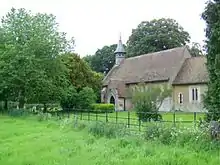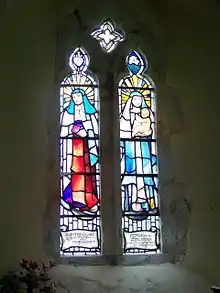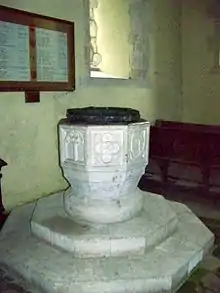St Leonard's Church, Hartley Mauditt
St Leonard's Church is a Church of England parish church in the hamlet of Hartley Mauditt, East Hampshire district of Hampshire, England. All that is left of the hamlet is the 12th-century church, the foundations of a manor house, and a large pond, Hartley Pond, which lies opposite the church on the other side of the road.[1] The church is dedicated to St Leonard.
| St Leonard's Church | |
|---|---|
 St Leonard's Church | |
 Location within Hampshire | |
| Location | Hartley Mauditt, |
| Country | England |
| Denomination | Anglican |
| History | |
| Founded | Early 12th century |
| Architecture | |
| Functional status | Active |
| Architectural type | Church |
| Style | Gothic |
| Specifications | |
| Materials | Stone |
| Administration | |
| Diocese | Winchester |
| Province | Canterbury |
| Clergy | |
| Bishop(s) | Bishop of Winchester |
History
The small church was constructed after the Norman Conquest, but its original simplicity was lost with subsequent workmanship, which was out of character with the style of the original building.[2] It was probably built by the de Mauditt family between 1100 and 1125.[3] It was restored and a bell turret on the west gable was added in 1853–4.
Architecture and fittings


St Leonard's consists of a nave, chancel, and south porch. The 13th century chancel contains some ancient monuments of the Stuart family. The chancel arch is a rare example of the horseshoe form. Some good early tiles on the chancel floor are notable. There are 34 tiles set in two lines on the chancel floor with seven designs.[4] The south doorway is from the end of the 12th century. Several of the windows contain stained glass.[5] Its octagonal font is of Decorated Period style, 15th century.[6][7]
References
- Driver, Leigh (25 September 2008). Lost Villages of England. New Holland Publishers. pp. 64–. ISBN 978-1-84773-218-7. Retrieved 4 March 2012.
- Moody, Henry (1846). Antiquarian and topographical sketches of Hampshire (Public domain ed.). pp. 110–. Retrieved 4 March 2012.
- "St Leonard's – Hartley Mauditt". worldham.org. Retrieved 5 March 2012.
- Hampshire Field Club and Archaeological Society (1952). Papers and Proceedings. p. 289. Retrieved 4 March 2012.
- White, William (1878). History, gazetteer and directory of the county of Hampshire: including the Isle of Wight, and comprising a general survey of the county and separate historical, statistical and topographical descriptions of all the hundreds, parishes, townships, chapelries, towns, ports, villages, hamlets, & unions; the diocese of Winchester; the seats of the nobility and gentry; magistrates and public officers; and a great variety of other archæological, architectural, agricultural, biographical, botanical and geological information (Public domain ed.). W. White. pp. 271–. Retrieved 4 March 2012.
- Cox, John Charles; Harvey, Alfred (1907). English church furniture (Public domain ed.). E.P. Dutton. pp. 201–. Retrieved 4 March 2012.
- Cox, John Charles (1905). Hampshire (Public domain ed.). Methuen. pp. 125–. Retrieved 4 March 2012.